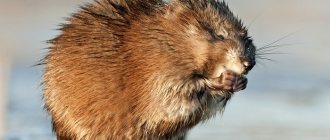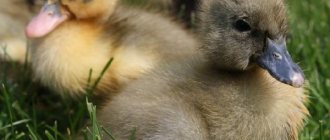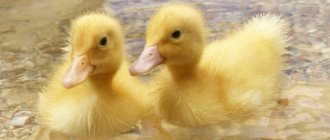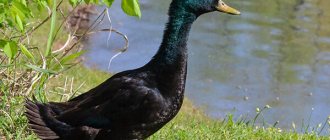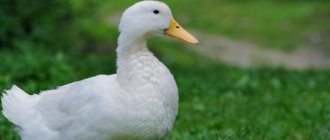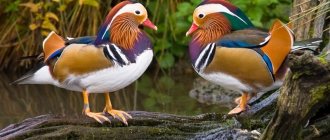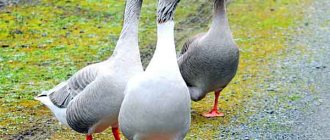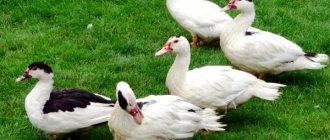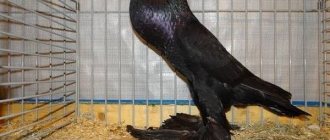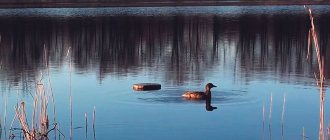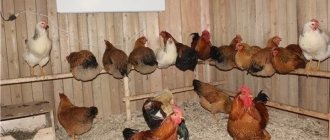The average person will not even be able to tell that this is a pochard duck, the body color and characteristics of this species are so varied. This cute duck mainly lives in rather unfriendly, cold conditions.
Its name is explained by the manner of “hunting” - the bird dives deep under water in search of food. These birds are not so easy to observe in their natural habitat, so not all of their habits and species characteristics have already been studied. They are very shy and immediately fly away at the first sign of danger, even leaving their own clutch.
Varieties of ducks
Experts distinguish 4 types of diving ducks:
- red-headed duck;
- blackness;
- marbled teal;
- dives.
The blackfish is similar in appearance to the duck, which is why they are often confused. The first one has medium size, a large head and a short neck. The beak is gray. The main distinguishing feature of this subspecies of ducks is a light stripe on both wings. Among the sage there are a number of subspecies. The most popular are sea ducks, American ducks, and tufted ducks. The sea duck very rarely comes out of the water onto land. Birds spend most of their time on the water. At the same time, they are able to submerge completely under water. There are 5 varieties of sage in Russia. You can also see the American Pochard, but only in flight.
The marbled teal is not very different in appearance from other species of pochards. It got its name from its light gray color. The bird weighs a little more than 0.5 kg. Mainly loves watery places surrounded by bushes or low trees. The marbled teal leads a calm and sedentary lifestyle. You can meet it in Central Asia, Spain, Russia and India. What distinguishes teal from other species is its ability to fly up trees. In addition, the bird can dive deep underwater.
The red-headed (pink-headed) duck is now unofficially classified as an extinct species. The last living representative of this bird species was seen in 1945. Since then, ornithologists have been actively searching for at least one living bird, but so far without success. However, experts note that there is a possibility that the pink-headed duck has survived in the wetlands of Myanmar. These places are uninhabited, and therefore it is not yet possible to study them.
Based on surviving images and descriptions, it is clear that these diving ducks had a striking appearance. The bird's head, neck and beak were painted pink. But only in males. The females were uniform in color, with the exception of the beak. The wings with pinkish tints were also striking in their beauty. The end of the plumage was white. Pink-headed ducks were miniature in size - their length barely exceeded 40 cm.
Duck ducks
These birds also dive to depths in order to get food for themselves. Ducks are very similar in appearance to ducks, so representatives of these genera are often confused with each other. These birds are distinguished by their small size, short neck and stocky body. The head of the duck is usually large and crowned with a relatively large black or gray beak. The following species of this genus of birds are known:
- Baer's duck;
- crested;
- polar;
- white-eyed duck;
- red-headed
These birds also dive to depths to get food.
Each variant of birds has its own characteristics. For example, the tufted duck reaches a weight of about 750 g and 45 cm in length. The drake's head is blue-green with a characteristic purple tint. The bird's body is covered with black feathers, but the belly and sides are white. The drakes have a small crest at the back. Females have more modest speckled plumage.
The diverse world of mallards
Mallard – Anas platyrhynchos is the most popular duck among hunters due to its excellent tasting meat. She has a rather small, short neck, a streamlined body, powerful short wings, and a relatively short tail tapering towards the end.
Mallard
The female’s outfit is inexpressive, with a predominance of reddish and brownish tones. The drake is immediately noticeable due to the combination of gray, brown, black colors with a white border along the edges of the feathers. The pearl-green head, on which a bright yellow beak flaunts, adds color to the overall image. The paws also have a color similar to the beak.
For habitat, the mallard prefers water bodies overgrown with reeds. They can feel great on a pond in a city park if you don't scare them. In September-October, large flocks of these ducks fly to Asia Minor, North Africa or China. On the return flight, a small group of about fifteen individuals usually gathers.
The genus Dabbling ducks includes several species of mallards.
African black duck - A. sparsa is distributed in the south and central territories of Africa.
African black duck
Madagascar mallard - A. melleri has a dark brown body, light gray beak, orange legs without gender differences.
Madagascar mallard
The yellow-billed mallard, A. undulate, is a common dabbling duck in southern and eastern Africa.
Yellow-billed duck
The American mallard, A. rubripes, inhabits the waters of eastern Canada.
American Black Duck
The Mexican mallard - A. diazi breeds in ponds and wetlands of the southern United States and Mexico.
Mexican mallard
Hawaiian mallard - A. wyviliana lives in river valleys and wetlands in Hawaii.
Hawaiian mallard
Laysan mallard - A. laysanensis has the same distribution area as the previous species.
Laysan mallard
The gray mallard - A. superciliosa is found in Australia, Indonesia, New Zealand, and New Guinea.
Mallard
Kinds
The diving duck type includes four more varieties. Among them are pochards, marbled teals, red-headed ducks and ducks. The birds are very attractive due to their neatness and bright plumage. Due to the same, they stand out well against the background of the natural landscape of their place of residence.
Dives
The diving duck of the genus Netta has a medium body size, but a rather large head on a short neck. If we compare the sizes, this duck is even slightly smaller than a mallard, which allows us to call it miniature. The weight of the bird is 0.9 kg. When comparing males and females, the former are always slightly larger.
It has many color variations, and the choice of a specific one depends solely on the variety. You can meet, for example, the red-eyed or red-nosed duck. The male most often has a light chest and only the head has a bright color, while the female most often looks like an ordinary gray duck.
This subspecies prefers to live in the forest-steppe or taiga, in places with temperate climatic zones. The main feature of diving is its low landing on the water. It obtains food exclusively by diving.
Cherneti
Cherneti are similar in appearance to Nyrks. They are often confused and mistakenly given the wrong name. The characteristic features of the appearance of this bird are its small size, stocky build and short neck. At the same time, the bird's head is very large and is crowned with a large gray or black beak. The color of the bird's paws is dark gray, they have leathery
This species of diving duck spends most of its time on the water. It can be submerged either completely or halfway. On land they can be found extremely rarely. Today you can find several varieties of Cherneti, among which the red-headed type is the most popular. American, sea and crested blackbirds are also found.
Marbled teal
At first glance, the Marbled Teal is no different from many other ducks. It has a completely inconspicuous plumage, not distinguished by a variety of colors. Surprisingly, both male and female teal have the same color. The feathers are brown-gray with light spots. An adult weighs on average about 0.6 kilograms.
You can meet the bird in Russia, Asia, Spain and even India. She has a peaceful and calm character, so she is sedentary and quite quiet. In the process of swimming, raises the tail. This is one of the few species of diving ducks that can be found in the tree - it often takes flight. It has a great diving depth.
In winter, this bird prefers to stay in large bodies of water that do not freeze. Today, there is a process of active decline in the population of this bird. The main reason for this disaster is active hunting for them, as well as the disappearance of small bodies of water that the Marbled Teal chooses as its habitat. The fact is that only in such quiet and secluded places can a bird organize its life, breed and raise offspring.
Pink-headed duck
Today, the Pink-headed Duck is unofficially recognized as an extinct species, if only because the last living individual was seen in 1945. Although ornithologists were actively searching for this bird, no evidence of its existence was found. But still, scientists have not lost hope; they are confident that the Pink-headed Duck can still be found in Myanmar, in the swampy northern areas where people do not live.
The appearance of this bird is memorable, as it is very bright. The males have a head, long beak and neck painted pink; the female has the same distinctive features, but the beak is not painted. The wings of these birds are especially beautiful - they have a pinkish tint, and the end of the plumage is white. The average length of an individual ranges from 41 to 43 centimeters, which indicates the rather miniature size of the bird.
Pink-headed ducks nest in tall grass. The standard clutch of one individual is 7 eggs with white shells. Pink-headed ducks are not found in the post-Soviet territory.
Features of diving ducks
The family Anatidae is included in the order Anseriformes of the class Birds - Aves. It is divided into three subfamilies. One of them is Real ducks (or Ducks) - Anatinae. In turn, the subfamily of ducks unites 8 tribes (a category in biology higher than the genus, but lower than the family), one of which is called the diving ducks - Aythyini.
Area and general description
Diving waterfowl received their common name due to a special method of obtaining food, mainly of animal origin, from the bottom through diving. The food is insect larvae, small crustaceans, and mollusks. Habitat is the northern hemisphere. A particularly large and diverse population of diving ducks is found in North America.
Habitat of diving ducks
The tribe Diving ducks includes ducks - Aythya and ducks - Netta. Common features are medium-sized, stocky birds with a large head. All of them, except teals, are distinguished by their colorful plumage. The hind toes of the short dark gray legs set back are equipped with leathery lobes. To take off from the surface of the water, diving ducks require a running start.
They are considered a valuable commercial game, although the fishy-smelling meat, due to the specific nutrition of ducks, is not as tasty as that of mallards and requires special processing. Boil the duck twice, draining the water completely. Only after this is the meat ready for further processing. It can be fried, made into cutlets, stewed, smoked.
An unusual documentary about ducks
Rod Cherneti
Cherneti - from lat. Aythya are characterized as stocky ducks with a short neck and large head with a gray or black wide, flattened beak. The light wide stripe on the wings makes it possible to distinguish representatives of this genus, as it is found in almost all species.
turn black
Blackfish stay on the surface of water bodies for a long time. They differ from dabbling ducks in that they are low-slung and carry their tails down. When getting food from the bottom, they dive easily, submerging completely or leaving only their back part above the water. It is practically impossible to meet these representatives of diving ducks on land.
Several species of the genus Cherneti are known, some of which, judging by their names, are close to diving.
- Tufted duck - Aythya fuligula is a widespread species that cannot be found only in the far north. Weight can reach 750 grams with a body length of up to 47 cm. Males of this diving duck in spring breeding plumage display black main plumage with snow-white sides, mirrors and belly. The image is complemented by the bluish-green coloring of the head, on which the crest hanging from the back of the head is clearly visible.
- Baer's Pochard - A. baeri - is a representative of the fauna of the Amur region, eastern Transbaikalia, and Primorye. Baer's Pochard
- Collared Duck - A. collaris prefers lakes in an area stretching from Nova Scotia to Alaska. Collared Duck
- The red-headed duck - A. ferina - has a wide distribution range in the Eurasian territory, extending west of Yakutia. Males of this species of diving ducks can reach a weight of up to 1300 grams, and females - up to 1100 grams. The mating appearance of the drake is characterized by several shades: a red crop and head, a black chest and feathers of the same color around the tail, light gray sides and back. The female has brownish-gray plumage with a characteristic light gray pattern flowing along the sides and back. Red-headed Duck
- Sea duck – A. marila nests in forest-tundra and tundra; Sea duck
- The white-eyed duck – A. nyroca – inhabits southern Europe and is also found in southern Siberia. White-eyed duck
Rod Nyrki
According to the classification, the genus Nyrkov - Netta includes several species:
- Red-eyed Pochard – N. erythrophthalma; Red-eyed Pochard
- Red-nosed Pochard – N. rufina; Red-nosed Pochard
- Pampas Pochard – N. peposaca. Pampas Pochard
Pochards are slightly smaller in size than mallards, have a short neck and a large head. They prefer to be on the water most of the time, very rarely going ashore. The tail is lowered down at a low landing. Drakes differ from females in being brighter in color. They are larger, reaching a weight of up to 900, and some types up to 1500 grams.
Pochard duck: varieties and lifestyle
The diving duck is an amazingly beautiful inhabitant of swamps and rivers. There are 4 varieties of these birds, differing not only in body size, but also in plumage color. This category currently includes pochards, ducks, teals and pink-headed ducks. These birds live mainly in the Northern Hemisphere. A large population of them has been identified in North America, where vast areas remain untouched by humans. A distinctive feature of all diving ducks is their ability to forage at great depths. This allows them to survive even in the harshest climatic zones. Few Russian ducks belong to the diving category. This is due to the characteristics of the reservoirs available in the country.
The diving duck is an amazingly beautiful inhabitant of swamps and rivers
White-bellied wigeon
Medium-sized dabbling duck. Its distinctive feature is its white belly. The male has a dark chestnut head with golden feathers on his forehead. The northern parts of Europe and Asia, as well as the tundra, are suitable for breeding wigeons. The diet of these birds includes plant roots, grains, as well as fry and tadpoles.
There are 2 types of wigeons.
Luxurious - the male and female are similar to each other. Their heads are greenish in color with a beautiful metallic sheen. The wings are reddish-beige. White and black feathers alternate beautifully on the chest.
American - lives in swamps. Inhabits the northwestern and central parts of the continent. During the breeding season, male representatives differ in color: pinkish sides and breast, black back, white spots on the wings. The head is grayish, the sides are green, the belly is white. The size of the bird is 45-56 cm.
Area and distinctive features
Representatives united in the genus Dabbling ducks are widespread almost everywhere, settling on mudflats and freshwater bodies of water, choosing shallow areas. Algae, plankton, and small invertebrates located in the surface layers of water are used as food.
Habitat of dabbling ducks
Their wide and fairly long beak is equipped with thin plates along the edges, through which the collected water is filtered, leaving a nutritious mixture in the mouth. Thanks to such a filtering apparatus, dabbling ducks almost never have to dive for food. They may occasionally submerge their front part into the water, although they do not do this very willingly.
They usually unite in pairs only when the mating period is approaching, followed by laying eggs. Nests are usually built on the ground. Sometimes, during prolonged flooding of nesting sites, they can settle on branches or in hollows of trees. Drakes are easily distinguished by their spectacular outfits from the modestly colored females.
They are considered the most valuable commercial game due to their tasty meat. In terms of size, the smallest river duck is a variety of teals, and the rest of the ducks are medium in size.
An unusual documentary about ducks
Habitat
These beautiful birds originally lived in East Asia. In Russia, they currently nest in the Primorsky and Khabarovsk Territories, in the Amur and Sakhalin regions. In the northern regions, mandarin ducks behave like migratory birds. In September they fly to China and Japan for the winter.
Mandarin ducks have a characteristic feature: they love to live on trees. Sometimes their hollows are found at a height of six meters. This unusual way of life forced the ducks to learn to jump from heights without any damage to themselves.
Mandarin ducks live near mountain streams, over which trees hang, and in forests near ponds. In Russia, due to its small number, this breed is listed in the Red Book. You cannot hunt such ducks; they are bred in parks and gardens as an ornamental breed.
As we have already said, birds prefer to nest near water, giving preference to windbreaks. On the female's command, the ducklings dive straight from the hollow and then learn to swim. The diet of mandarin ducks includes fish, beetles, snails, plant seeds, acorns and frogs. Ducks can rise vertically in the air, and therefore they can easily find food in oak plantings. In addition, tangerines feed on rice, cereal shoots, and buckwheat.
Types and characteristics of diving ducks
The diving duck has an unusual feather color and can often be seen on any body of water. In nature, there are many subspecies of this duck. What is this waterfowl? The subfamily of ducks has a special tribe, which is something between a family and a genus and is called a category. This includes diving ducks.
The diving duck has an unusual feather color and can often be seen on any body of water.
Common types
The diving duck type includes 4 more subspecies. Among them:
- diving;
- marbled teals;
- red-headed ducks;
- blackness.
- Dives. The body is not large, but the head is quite large on a short neck. The bird is slightly smaller than a mallard, the bird weighs about 1 kg. The male is always slightly larger than the female. The male usually has a light-colored breast and only the head is beautifully colored, while the female resembles an ordinary gray duck. They live in the forest-steppe zone of Russia. The main feature is a low landing on the water surface. It seeks food only by diving.
- Cherneti. Features of appearance: dense body build and shortened neck. The head is quite large, the beak is voluminous grayish or black. The paws are dark gray and have leathery membranes. The main feature that distinguishes blacks is a light stripe on each wing. The diving duck subspecies spends most of its time on the surface of the water. Today you can find several subspecies, among which the red-headed duck is common.
- Marbled teal. Both male and female are the same color. The plumage is brownish-grayish with lightened inserts. An adult weighs about 0.6 kg. You can meet the bird in the European part of Russia and Asian countries. It has a non-aggressive character, so it moves little and behaves calmly. During swimming, it raises the tail section. It differs in that it dives very deeply. Winters in large bodies of water that are not covered with ice. The population of this bird is observed to disappear. The main reasons: hunting for them and shallowing of water bodies. Can build a nest only in a safe and quiet place.
- Pink-headed duck. According to unofficial data, it is an extinct species. The bird was last seen in 1945. Ornithologists are sure that the bird can be seen in Myanmar, in the swamps of the north, in deserted places. The plumage color is bright and beautiful. Males have a pinkish head, elongated beak and neck; the female’s beak is not colored. The wings are pink and the tips of the feathers are white. The average length is 41-43 cm. Nests are located in tall grass. The usual clutch of one female is 7 eggs. Pink-headed ducks cannot be found in Russia.
Messengers of warmth: species of starlings and their habitat
Other representatives
The red-nosed subspecies is also of interest. The male has thick down on his head. The head is reddish-reddish in color. The chest and abdomen of this bird are black, and the lateral parts are white, in sharp contrast with the brownish back.
The species received its name because of its black beak, which has a red stripe on its side. Ducks feed mainly on inhabitants of water bodies. These can be crustaceans, small fish, insects. Poultry meat has a peculiar fishy taste that does not go away during heat treatment.
Ornithologists classify 12 species as common dives. Some of them build nests in tropical countries. Popular among hunters are the crested and saltwater species. They are called blackening. This has to do with the color. The bird is black in color (especially in the upper part of the body).
The sea duck settles on the coast and builds nests among the stones.
The royal species lives in the waters of North America and is suitable for hunting. All varieties of wild duck have meat with an unusual taste. You need to know how to cook it: the bird is boiled in 2 waters (the first one is poured out, then boiled again, and this water is also poured out). After such cooking, game can be prepared in any way: stewing, frying, smoking.
There are about 30 subspecies in Russia. Ducks raise their offspring in secluded places, for example, in estuaries, where reeds and a lot of different food grow like a wall, both plant and living creatures in the form of small fish and worms. When the ducklings grow up, the bird goes to sea.
Waxwing bird: description, way of life in nature
True facts
They get their food by diving from here, which is where they got their name. Their food:
- various kinds of insects;
- shellfish;
- crustaceans.
Pochards create unusual nests very close to the water in very thick grass. Range - distribution on the planet - birds cover the northern hemisphere.
diving ducks
These species include diving:
- Cherneti.
- Pink-headed duck.
- Teal.
The behavior of these ducks is quite attractive, and it has attracted the attention of scientific ornithologists. Even now, these beautiful birds have not been fully studied. Currently there are 3 subspecies of these birds :
- Red-eyed.
- Pompous.
- Red-nosed.
These birds are small in size, they have a rather large head and a short neck. When swimming, they keep their tail down and have a low position on the water. They practically do not live on the shore. Each type is worth considering separately.
Pochard duck photo and description, species: duck, goldeneye, marbled teal, and pink-headed
Wild duck meat has a unique taste, is a source of amino acids and useful elements, but it should be prepared according to a special recipe.
Most of the diving ducks are also considered game birds. Some of their species are close to extinction and are protected by law. For this reason, the hunter needs to know the habits, habitats, and external features of ducks, the shooting of which is prohibited.
Descriptions and habitats of different species of ducks
Thanks to the special method of obtaining food, the duck received such a unique name “dive”.
Wild duck meat has a unique taste and is a source of amino acids and beneficial elements.
Diving as deep as possible into the water, it collects food from the bottom.
Most ducks prefer to feed on small living organisms rather than plant foods.
Diving ducks live in different regions of the globe. Some species of these birds are adapted to harsh climatic conditions, others are thermophilic. Only a few species are considered migratory.
The diving duck is not a large bird. Relative to body size, they have a large head, but a short neck. They spend most of their time on the water, although they also feel confident on the shore.
During the mating season, drakes take interesting care of females. They build nests in secluded places of reservoirs from leaves, reed stems, the bottom is lined with down.
The clutch is carefully protected until the ducklings emerge, which very quickly become independent.
Red-headed Pochard, or Blue Duck
Lives in Europe, northern Africa.
The red-headed duck is an excellent swimmer and diver.
In our country there is:
- in the northern regions of the European part;
- on the Kuril Islands;
- in Bashkortostan;
- in the south of Udmurtia;
- on the banks of the Yenisei, Angara, Baikal.
The red-headed duck grows to medium size, its weight rarely exceeds 1 kg.
Plumage of a drake during the mating season:
- ocher-red head with a violet sheen;
- black belly and breast;
- gray-blue back;
- bluish-gray beak.
Pairs form when returning to nesting sites. The process of courting a female is a whole ritual: the drake spins around her, lifts its head, whistles softly, and sometimes falls forward with a hoarse cough.
Nests are built in the thick of water thickets. Blue ducks do not leave the duck while the eggs are hatching, usually there are from 7 to 12 of them.
Ducklings appear after 24-26 days. After a few days, the duckling dives and feeds on its own. After 2 months, these are already fully feathered ducks, standing on their wings.
These are hardy birds that fly quickly and noisily, and dive deep and often when searching for food.
Gogol
Habitats: swamps and rivers of tundra and forest-tundra.
On the territory of our country, the goldeneye lives in the following places:
- southern shore of Lake Baikal;
- Primorye;
- Kazakhstan.
The birds arrive at their permanent habitats in March-April. Flocks are small, approximately 10-16 individuals.
Gogol ordinary
Approximate duck parameters:
- weight – about 1 kg;
- torso – 50 cm;
- wingspan – 70-75 cm.
Distinctive features are a triangular head and a short beak with a pointed tip.
Duck color:
- black, shiny feathers with a metallic tint on the head;
- white spots in the beak and eye area;
- the back, wings and tail are black, the rest of the body is white;
- there is a black stripe on the sides, and a white stripe on the wings.
The bird flies noisily and quickly.
Gogol prefers animal food, for which it dives to a depth of 11 m. During hungry periods, it can feed on seeds and roots of aquatic plants. Loves ponds with trees along the banks.
The male chooses the female he likes and creates a pair with her for many years. They organize nests in the roots or hollows of trees, among firewood or in dry grass. Couples can return to a place they like several times.
The duck lays up to 15 greenish eggs. They hatch for approximately 1 month.
Conclusion
The genus of diving ducks is diverse; all species are beautiful and interesting. Having studied the features of their behavior, you can distinguish them from the river duck (mallard) and determine which species a particular bird belongs to.
Rod blacken
The genus blacken, in turn, is also divided into several subspecies. These ducks are distinguished by a large head, short neck, flat and wide beak.
Red-headed Pochard, or Blue Duck
Lives in Europe, northern Africa.
The red-headed duck is an excellent swimmer and diver.
In our country there is:
- in the northern regions of the European part;
- on the Kuril Islands;
- in Bashkortostan;
- in the south of Udmurtia;
- on the banks of the Yenisei, Angara, Baikal.
Be sure to read:
Blue favorite ducks: breeding at home, cultivation and characteristics of the breed
The red-headed duck grows to medium size, its weight rarely exceeds 1 kg.
Plumage of a drake during the mating season:
- ocher-red head with a violet sheen;
- black belly and breast;
- gray-blue back;
- bluish-gray beak.
Pairs form when returning to nesting sites. The process of courting a female is a whole ritual: the drake spins around her, lifts its head, whistles softly, and sometimes falls forward with a hoarse cough.
Nests are built in the thick of water thickets. Blue ducks do not leave the duck while the eggs are hatching, usually there are from 7 to 12 of them.
Ducklings appear after 24-26 days. After a few days, the duckling dives and feeds on its own. After 2 months, these are already fully feathered ducks, standing on their wings.
These are hardy birds that fly quickly and noisily, and dive deep and often when searching for food.
White-eyed Pochard
The identifying feature is a white iris and an almost black belly.
Meeting a white-eyed duck is a real success for a hunter
Previously, in the Russian Federation, the habitat of birds reached up to 560 N latitude, in the east it extended to the Altai Territory. Now this is Europe, the western part of Asia, Kazakhstan. They winter on the shores of the Mediterranean Sea, in the south of the Caspian Sea, and in southwest Asia.
The bird eats plant foods, its meat has an excellent taste.
The duck is characterized by its small size:
- weight – up to 800 g;
- body length – up to 42 cm;
- wing – 17-19 cm.
For nesting, the bird chooses reed thickets, dense vegetation in the middle of shallow rivers, and occasionally along the banks. Individuals gather in colonies and build nests close to each other.
There are no more than 15 eggs in the nest, which are incubated by the female. The incubation period is 24-28 days. The drake does not move far from the nest and helps in nursing the ducklings. After 55 days they are already flying.
The duck is an endangered species.
Baer's dive
This is a small duck, its weight does not exceed 400 g. A distinctive feature is a massive cranial bone.
Baer's Pochard has unusually bright plumage for a duck.
Baer's duck is widespread in a narrow area:
- banks of the Ussuri;
- Ussuro-Khanka Valley;
- Beginning of the Zeya River;
- Coastal zone of Lake Baikal.
You can see it in China and Korea. Ducks fly to India for the winter.
The drake’s “outfit” during the mating season is bright, the female is “dressed” more modestly. The courtship ritual is accompanied by flying around the duck with peculiar cries.
The Baer's Pochard is a carnivore.
Dives
Prominent representatives of diving ducks are a genus of medium-sized ducks with a large head and short neck. They got their name, like other representatives of the diving genus, for diving in search of food.
A significant part of the time they live on open water reaches, rarely coming onto land.
Subspecies and range
There are 3 main subspecies in the diving genus:
- The red-nosed bird is large in its kind, gaining weight up to 1.5 kg, recognizable by its brightly colored red head and bright red beak, unlike other generic birds, it moves more freely on land, in case of danger it can run, but dives worse than others, often frozen in a candle pose;
- Red-eyed - got its name because of the red iris of the eyes, the color is dark brown, closer to black, length - up to 0.5 m;
- Pampas - distinguished by a large red and white beak, which contrasts with the black head.
The distribution geography of the red-nosed pochard covers the deltas of Russian rivers - the Volga, Amu Darya, and the southern part of Balkhash. It is common in Western European countries and is found on the islands of the Mediterranean Sea in Central Asia. The red-nosed duck avoids salty waters, preferring fresh ones.
The red-eyed subspecies breeds in the south of the African continent and is found in Latin American regions, preferring fresh lakes and wetlands.
The pampas pochard is a resident of the South American continent and central Chile, present in the northern regions of Argentina and Uruguay.
There are 3 main subspecies of pochards: red-nosed, red-eyed and pampas
Representatives of the genus of dives
Several representatives of the extensive duck family belong to this category. The behavior of these birds has long attracted the attention of ornithologists, thanks to which several genera of ducks have received the name diving. Even now, everything is not known about these unique creatures and the reasons for this behavior. Currently, this genus of ducks includes 3 species of birds, including the red-eyed, red-crested and pampas pochard. These creatures are medium in size, have a relatively large head and a short neck. While swimming, they try to keep their tail down, so their landing position on the water is very low. These birds do not collect food on the surface, but dive to a certain depth for it. It is worth considering in more detail all representatives of this genus.
The red-nosed duck has the following distinctive features:
- weight - up to 1.5 kg;
- body length - up to 55 cm.
- brown plumage and red nose in males;
- gray-brown plumage in females.
There are 4 varieties of these birds, differing not only in body size, but also in plumage color.
The color of the bird's coat changes throughout the season. This is especially true for drakes. These diving ducks have gray-brown plumage on the back, wings and top of the head throughout the year. Only the cheeks and abdomen are distinguished by a light shade. In summer, drakes are practically no different from females, but they still have red beaks and a crest. Drakes transform for the breeding season. Their upper body takes on a rich red hue. The crest, formed from elongated feathers, visually greatly enlarges the head. The plumage on the belly becomes black and shiny. The sides and mirrors acquire a characteristic white color, which gives males contrast and makes them attractive to partners. Thus, the red-headed duck is such only in the spring.
Features of various types
Pochard ducks, belonging to the Netta tribe, are medium in size and have a squat constitution. According to the modern classification proposed by Russian ornithologists, these include 3 species:
- red-eyed;
- red-nosed;
- pampas.
Red-nosed
ducks Red-nosed ducks are represented by fairly large individuals, their weight reaches 1.6 kg. The drakes have a spectacular feather color: an orange head, a black breast, and a scarlet beak contrast with the beige background of the back. The head is decorated with a fluffy plume. The habitat of red-nosed ducks is Portugal, Spain, the Mediterranean coast, in Russia they are found in the Volga region. They fly well and are capable of staying in the air for long periods of time. They spend most of their time on the shore, do not dive well, prefer to collect food from the surface of the water, and often turn head down, raising their webbed feet and tail above the lake.
Red-eyed ducks are also called southern, which reflects their distribution area - areas of Central Africa and Latin America. These birds are characterized by their small weight and gather in small flocks. In male ducks, bright feather color prevails: the breast is in purple tones, the head is black, the back is beige-brown. The iris is a deep scarlet color, which determined the species name.
One of the beautiful species of wild ducks is the pampas duck, which lives in Latin America, off the coast of Argentina. They prefer slightly salted water of sea lagoons, lakes, and straits. Pampas ducks, as described by ornithologists, are distinguished by their colorful plumage. The gray wings are edged with white; against the background of the black chest and head, a white beak with a red base and a black tip stands out. Their diet is dominated by plant foods - algae, reed shoots, various seeds.
Cherneti
Blackfish are very similar to other representatives of diving, and they are given erroneous names. This species is distinguished by its strict coloration. These birds have a gray or black beak. The paws are also dark gray in color. They have a wide light stripe on their wings. The feet of these ducks are shifted back. Unlike other species, they take off with a running start. There are 5 species of the Cherneti genus:
- Baer's duck.
- Arctic duck.
- Red-headed duck.
- Tufted duck.
- White-eyed duck.
The Tufted Duck weighs approximately 750 grams and is 45 cm long. The drake has a blue-green head color. The body is covered with black feathers, but the belly and sides are white. They have a crest at the back, hence the name crested. Females have more modest plumage.
Almost everyone knows the red-headed duck. Its weight is about 500–1200 grams, and its length reaches 45 cm. Drakes have a characteristic color during reproduction. The chest and head become red, the tail is black, the back and sides are light gray. Females have a camouflage coloration, dirty gray, thanks to which they safely hide from predators.
Baer's ducks are a very rare species, which were named in honor of Karl Ernst Bon Baer. Baer males have a black color with a green tint, in which their head and neck are painted. And in the female these parts of the body are blackish-red. This species lives in areas overgrown with reeds. But their numbers are declining due to a reduction in the territories they need for nesting.
The white-eyed duck (Australian) can be found on the island of Java, although Australia is considered their homeland. Their plumage is thick and chocolate-colored. Males have unusually colored eyes; they have a whitish iris. Females are similar to males, but have dark eyes. Their habitats are overgrown lakes along the shores.
Marbled teal
Small duck, drake plumage and females are similar . The only difference is the presence of a small crest on the male’s head. Gray feathers predominate in color; spots of a lighter tone are visible on the back.
The marbled teal lives only in deserts. It nests in shallow, heavily overgrown brackish water bodies with reeds. It builds its nest in a dry place, surrounded on all sides by grass or bushes.
Be sure to read:
The largest breeds of domestic and wild ducks, species for breeding
Ducks lay 7-12 eggs; they do this from late May to early July. Marbled teals are adapted to a secretive lifestyle and gather in small flocks. They feed on plant and animal foods.
Marbled teal
They fly quickly, usually in a straight path.
Ducks of the genus Pochard
This genus includes:
Ornithological scientists have not fully studied the behavior of some species of these birds.
Red-nosed Pochard
The red-nosed duck is a strong and large bird.
The steppe zone and semi-deserts located from the Mediterranean Sea to the east of Turkmenistan are a favorite nesting place for birds.
In the Russian Federation, habitats are located in the following areas:
- Volga region;
- Mordovia;
- Altai Territory;
- Western Siberia.
Red ducks can fly long distances. Despite the fact that they fly quickly and easily, they take off from the water surface awkwardly and with a lot of noise.
While above the water, red-nosed ducks fly as close to the surface as possible. The flight above the earth takes place high in the sky.
Rednose fish can stay on the shore for a long time and move quickly on the ground. Like dabbling ducks, they have a high carriage when swimming.
The red-nosed duck is a strong and large bird
They do not dive in search of food, but lower their heads into the water, and their paws and tail rise perpendicularly above the reservoir. After 2 years, the duck is considered sexually mature.
During the mating season, the drake has a beautiful coloration:
- the head and part of the neck acquire an ocher-red color;
- beak and paws – red-pink;
- lower part of the neck, belly – black;
- back – brown-gray;
- the head is decorated with a fluffy crest.
The duck's "outfit" is less bright. Trying to interest her, the drake fluffs up the feathers on his head, sticks out his chest, whistles, and walks around her.
Red-nosed ducks nest on grassy islands in the center of rivers and lakes, in thickets near the shore, and on last year's reed heaps.
The female lays an average of 6-9 olive-colored eggs with a gray or brown tint and incubates them for 28 days. These are very cautious birds that, in case of any danger, leave the nest with the clutch.
After approximately 4 weeks, the chicks appear.
Red-eyed Pochard
This duck got its name from the scarlet color of its iris. Another name for the bird – southern – reflects the geography of its habitat.
The duck has impressive dimensions for wild individuals:
- the weight of the drake reaches up to 1.2 kg, females - 1.0-1.2 kg;
- wing size – 240-280 mm;
- beak length – 44-54 mm.
Habitat areas:
- steppes of Central Asia;
- north of the Caspian Sea.
Sometimes found in reservoirs:
- Kuban;
- Volga-Ural region;
- Bashkiria;
- Northern part of Tajikistan.
These are migratory birds.
They return to nesting sites in April. At this time, pairs are actively formed. During the mating season, the drake is easily distinguished by its bright red head, which appears very large due to the enlarged feathers on the back of the head.
Birds nest in colonies. After laying the egg, the female incubates it. Drakes unite in flocks. Molting begins in June.
Flight to warmer regions begins in September-October.
The red-eyed duck prefers plant foods, so its meat does not have a specific fishy taste.
Pampas dive
Lives in the south of South America. On the eve of winter, it flies to the south of Argentina, Brazil or Bolivia.
It can be seen in the zoo; its beautiful coloring provides special interest:
- the back and wings are ash-blue, with a white stripe along the edges of the wings;
- belly – light gray;
- head and chest are black.
The pampas duck lives in shallow reservoirs and coastal sea waters. It builds nests in the depths of vegetation, on reed creases. The duck lays 10-12 eggs and incubates on its own for 27-29 days.
The pampas duck feeds mainly on plant foods that grow at the bottom of reservoirs and in the coastal zone. While foraging, their head and upper body are immersed in water, while their paws and tail remain on the surface.
Varieties of dives
All divers are united not only by the ability to dive under water to a significant depth, but also by body shape, flight characteristics, and lifestyle. Pochard is a medium-sized duck. The body is compact and muscular. Pochards have a large, rounded head. The beak has a slightly flattened plate. The duck's neck is short but thick.
Flight muscles are well developed. A distinctive feature of all diving fish is the membrane of skin on the posterior phalanx of the limbs. The order of ducks includes the following species of ducks: red-eyed duck, red-nosed duck and pampas duck. How do they look? Where do they live?
Red-eyed Pochard
The duck got its name from the bright red color of the iris. The bird's head is a rich chestnut color. Against the background of the plumage, the eyes glow like bright lights. The duck is small in size. Body length no more than 50 cm, weight on average 1.3 kg. Drakes are larger and brighter than females.
Males get their beautiful plumage after the autumn molt. It is necessary to attract females. At the end of the mating season, when the birds have already created a family, individuals experience a change of feathers. Drakes differ from females only in their greater weight:
- The drake's body is chocolate-colored, its wings and sides are piebald, and its belly is white. The chest has a gray tint. The feathers are cast in a muted pink color;
- The feather cover of females is discreet. Ducks are gray. The head does not differ in shade from the body. Eyes can be scarlet or black;
- the mirror in both the female and the male is formed by white flight feathers with a gray edge;
- The duck's beak and metatarsals are bright black.
Red-eyed diving ducks live in South America, on the shores of the Red Sea, on the African coast of the Atlantic and Indian Oceans. A small population of birds found in Madagascar. Individuals are not migratory. They are not considered game birds. The red-eyed duck is listed in the International Red Book.
Red-nosed birds
Red-nosed ducks, like red-eyed ducks, have a bright scarlet iris, but their plumage has more saturated tones. During the mating season, drakes are covered with bright clothes. Their heads, like those of the red-eyed individuals, are chestnut-colored. The back and chest are black with a green tint. The wings, tail feathers and rump are dark. The wings are a light cream color. The mirror is formed by white feathers with a black edging.
The feather cover of females is predominantly brown. The beak of both the drake and females is bright red, narrow, but slightly flattened on the sides. The tip of the nose is bent down. Individuals have a horizontal landing. The tail is lowered and lies on the water. The feathers form a fan.
The main population of ducks is found on the Mediterranean coast. Birds occupy almost the entire Iberian Peninsula. Here individuals lead a sedentary lifestyle. The red-nosed duck also lives in the regions of Central Asia.
Ducks are common on the banks of the Volga, Syr Darya, and Lake Balkhash. A small settlement is located in Western Europe. From European countries and the northern regions of Asia, the duck migrates to the west of China, the south of Kazakhstan, and to the shores of the Mediterranean Sea.
The red-nose pochard weighs 1.7 kg. It is a game bird. The species is not listed in the Red Book. Not only meat is obtained from ducks, but also bright feathers, which are used to make jewelry. Down has high thermal insulation properties. The meat is dark red, the subcutaneous fat is orange. The carcass itself looks unattractive, but all this does not prevent the game from being used for food.
Pampas dive
The duck of this species has a limited, endemic habitat. Ornithologists note small populations of birds in Latin America, on the Falkland Islands in the southwest Atlantic Ocean. Individuals prefer salty water. They are not found in fresh water bodies:
- the plumage is distinguished by a noble silvery tint with small splashes of white;
- the head and chest are dark purple. In the sun the feather has a pink tint;
- belly white;
- flight feathers are light with a black border;
- the iris of the eyes is red. It stands out clearly against the purple background of the plumage.
LIFESTYLE
The Ruddy Pochard is one of the most abundant European diving ducks. In most of its range, the red-headed pochard is a migratory bird. Several hundred thousand of these birds winter in Central Europe, but few of them nest here. Flocks of ducks arrive in Central Europe in October and fly to nesting sites further north or west in April.
Red-headed ducks also nest in Central Europe, but in small numbers. They make nests near lakes, ponds, slow-flowing rivers and artificial reservoirs, where there is enough food. Red-headed Pochards live in small groups most of the year; in winter they form large flocks of up to 500 birds. Flocks of thousands of these birds sometimes gather at moulting sites. Red-headed Pochards form joint flocks with other bird species, such as herons, and, in the north, with sea ducks.
When on vacation, ducks keep in schools, which include only individuals of this species. The red-headed duck swims like other grebes: with its legs stretched far back and its tail half-submerged in the water.
The dive cannot take off immediately from the water - for this it needs acceleration. Therefore, in case of danger, the red-headed duck does not fly away, but swims away or dives. It takes off quite difficult, along an inclined line, but flies quickly, with a characteristic noise. In most of its range, the red-headed pochard is a migratory bird.

